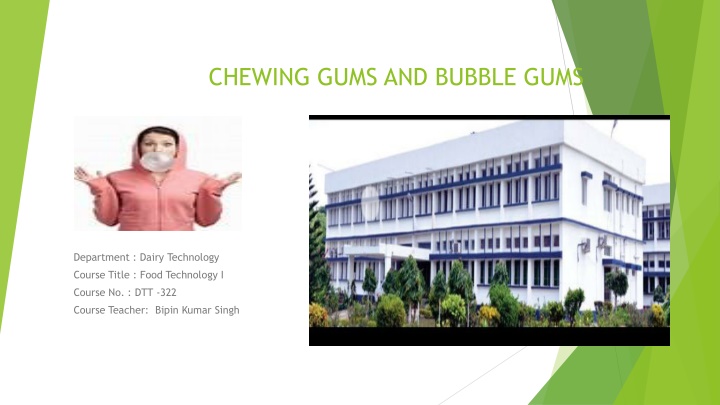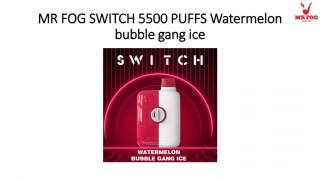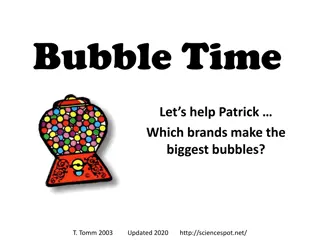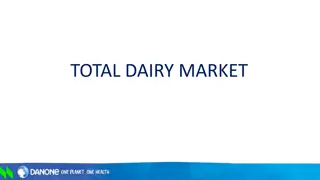Chewing Gums and Bubble Gums in Dairy Technology - An Overview
Chewing gum and bubble gum are popular confectionery products made with specific ingredients such as gum base, sweeteners, flavors, and colors. These gums have distinct characteristics and are produced by major companies like Arcor Group and Mars, Incorporated. The role of ingredients like hydrocolloids and gelatin in the manufacturing process is crucial for texture and quality.
Download Presentation

Please find below an Image/Link to download the presentation.
The content on the website is provided AS IS for your information and personal use only. It may not be sold, licensed, or shared on other websites without obtaining consent from the author.If you encounter any issues during the download, it is possible that the publisher has removed the file from their server.
You are allowed to download the files provided on this website for personal or commercial use, subject to the condition that they are used lawfully. All files are the property of their respective owners.
The content on the website is provided AS IS for your information and personal use only. It may not be sold, licensed, or shared on other websites without obtaining consent from the author.
E N D
Presentation Transcript
CHEWING GUMS AND BUBBLE GUMS Department : Dairy Technology Course Title : Food Technology I Course No. : DTT -322 Course Teacher: Bipin Kumar Singh
Chewing gum Chewing gum is a soft, cohesive substance designed in order to be chewed without being swallowed. Modern chewing gum is composed of gum base, sweeteners, softeners/plasticizers, flavors, colors, and, typically, a hard or powdered polyol coating.Its texture is reminiscent of rubber because of the physical-chemical properties of its polymer, plasticizer, and resin components, which contribute to its elastic-plastic, sticky, chewy characteristics. Chewing gum is a type of gum traditionally made of chicle, a natural latex obtained from the sapodilla tree (Manilkara chicle) and jelutong-pontianank, latex of jeluotong tree. Either of the latexes was considered as main components for making chewing gum base.
Bubble gum and chewing gum Both bubble gum and chewing gum are normally sweetened and many companies add a type of flavoring to their gum. The main flavor chewing gum is mint, but it s possible to find flavors such as watermelon and liquorice. There more bubble gum flavors than chewing gum, for example, strawberry, blueberry, grape and many more. are usually
Major Producers Arcor Group Cloetta AB Ferndale Confectionery Pty Ltd. Haribo GmbH & Co. Kg Lotte Confectionery Mars, Incorporated The Wm. Wrigley Jr. Company Meiji Holdings Company, Ltd. Peppersmith Perfetti Van Melle The Hershey Company
Role of Ingredients Used in Chewing Gum Hydrocolloids: Hydrocolloids are the key ingredients for gums manufacture. They are high molecular weight polymers of plant, animal or microbial origin that form viscous solutions or gels on addition of water. Some of the Hydrocolloids are given below: Agar agar: It is a seaweed and swells in water and exhibits a high gelling power at low (1-2%) concentrations to give a hard-brittle short-breaking bite with good clarity. It is one of the most potential gel-forming agents known. The strength is mainly proportional to the agarose rather than agaropectin content, which forms double helices on gelation. It has a unique property to form gels which only sets at 32-39 C yet does not melt until temperature reaches 85-90 C. This aspect is advantageous in allowing the incorporation of flavours, acids, colours, etc. at cooler temperatures prior to shaping and setting. Bacterial gums: Xanthan gum from Xanthomonas campestris, gellan gum from the fermentation of Pseudomonas elodea, etc. are potential gums which find applications in confectionery. Gellan is functional at very low concentration (about 0.5%) to give hard-brittle short-textured gels. Setting temperature is 40-50 C yet melting temperature is 90-100 C.
Role of Ingredients Used in Chewing Gum Gelatin:Food grade gelatin is made by aqueous extraction of mammalian collagen by lime or acid treatments of skin, bovine or porcine raw materials. Religious reasons may prevent the use of porcine sources. The thermoreversibility of gelatin gels (at around 40 C) gives its main organoleptic feature of a smooth elastic texture which melts agreeably in the mouth. Commercial gelatin is available in leaf, sheet, granule and powder forms. In India, as per Food Safety and Standards (2011) Rules, food grade gelatin is permitted as an additive. Gum acacia:It is a tree exudate, where it forms as tears and also called as gum arabic. Each tree yields between 50 and 100 g of gum per year. It is available in lumps, powdered and as purified, standardized, spray-dried. It is the preferred hydrocolloid for many long-lasting, chewy, gum sweets and is used at levels from 10- 60%. Resistance to melt away, shape stability, good clarity, bland taste and odour with minimal sweetness and pliable texture with low adhesion during consumption are the key factors of this gum. Its viscosity reduces greatly with increased temperature, making it suitable for fluid-deposited goods.
Role of Ingredients Used in Chewing Gum Pectin:It is a polymer of galacturonic acid obtained mainly from apple or citrus fruits. Pectins are characterized by methoxylation and gel strength. It forms gels at 0.5-4.0% concentration and have a delicate fruit-like short texture and mouth feel with very good flavour release. Low-methoxy pectin does not require acid and a good gel can be obtained by diffusing calcium ions into the system. their degree of esterification or Modified starches:They are the starches modified by chemical reaction or physical means in order to adapt it for a specific application or improve its stability. Chemical modifications include phosphorylation, oxidation, etc. Physical modifications involve pre-gelatinization of starch by drying or heating. Corn or maize starch is the most commonly used starch although tapioca (sago), rice, wheat and potato starches can be employed to modify textures. cross linking, acetylation,
Sugars In the chewing gum manufacture, sugar used shall be of very fine particle size (less than 20 microns) to avoid gritty feel in the mouth. Chewing gum, therefore, has to be made from milled sugar similar to icing sugar. Milled sugar is difficult to handle and if exposed to high humidity they agglomerate. Therefore, the confectioners procure crystalline sugar and mill it on-site and feed the milled sugar directly into the manufacturing process. Sugar is usually added at a rate of about 25% of the gum base. Dextrose monohydrate is sometimes used as an alternative to sucrose in chewing gum. The endothermic heat of solution of dextrose gives a cooling sensation in the mouth, a property that goes well with mint flavours but not with others. To achieve a final TSS content of at least 75%, glucose syrup or doctors are incorporated.
Texturizers Texturizers are substances that are added to the gum base to modify the mouth feel and facilitate processing. Common texturizers are food grade calcium carbonate or talc. Both of these are less expensive than the other ingredients in gum base. Low cost chewing gum bases contain about 45-55% texturizers whereas high quality chewing gum base contains 18-20%. Bubble gum bases have a texturizer level varying between 30 and 60%. Calcium carbonate is not an acceptable texturizer in products where there is an acid component to the flavour as it reacts with the acid to produce carbon dioxide. Typically acids are only used in fruit-flavoured products, and here, talc must be used as a texturizer.
Humectants Chewing gum can be spoiled by either loss or gain of moisture. If the gum picks up too much moisture it will become too soft and could darken; if the gum dries out it becomes too hard. Either of these problems can be prevented by wrapping the product in a moisture-proof barrier. However, it is common to add humectants to chewing gum in order to lower the water activity and hence reduce drying out. Common humectants used are sorbitol and glycerol. While sorbitol is a purely vegetable product, glycerol can be produced by the hydrolysis of fat including animal fats, which can cause problems with some religious and ethnic groups. Glycerol petrochemical origin. Excess use of humectants can make the products soft and sticky. can also be produced from
Antioxidants Gum bases are prone to oxidation and antioxidants help in preventing it. Typically, they contain permitted hydroxytoulene (BHT), butylated hydroxyanisole However, in India, only BHA maximum up to 250 ppm is permitted in chewing gums as per Food Safety and Standards Rules (2011). antioxidants such as butylated tocopherols. (BHA) or
Colours Permitted colours are invariably added as solutions at the end of the mixing operation in the process. Colours must be acid-fast, resistant to reducing sugars, stable to operating temperatures and should not separate into basic colours during the gel-setting operation
Flavours Addition of flavours enhances the acceptability of chewing gums. Adding flavours to warm liquors under atmospheric conditions can lead to loss of volatiles, and hence, in-line mixing is preferable. Medicated flavours such as menthol and alcohols such as gin are especially susceptible. Small quantities of salt can sometimes be used to enhance the perception of non-fruit flavours.
Manufacturing of Chewing or Bubble Gum Gelling agent sugar and glucose syrup other ingredients (texturizer, colour, flavour etc.) dissolving concentration shaping stoving sweet finishing chewing gum or bubble gum
Quality and safety Chewing gum is rather shelf stable because of its non-reactive nature and low moisture content. The water activity of chewing gum ranges from 0.40 to 0.65.The moisture content of chewing gum ranges from three to six percent. In fact, chewing gum retains its quality for so long that, in most countries, it is not required by law to be labeled with an expiration date. If chewing gum remains in a stable environment, over time the gum may become brittle or lose some of its flavor, but it will never be unsafe to eat. If chewing gum is exposed to moisture, over time water migration may occur, making the gum soggy. In lollipops with a gum center, water migration can lead to the end of the product's shelf life, causing the exterior hard candy shell to soften and the interior gum center to harden.
Physical and chemical characteristics Chewiness: The polymers that make up the main component of chewing gum base are hydrophobic. This property is essential because it allows for retention of physical properties throughout the mastication process. Because the polymers of gum repel water, the water- based saliva system in a consumer's mouth will dissolve the sugars and flavorings in chewing gum, but not the gum base itself. This allows for gum to be chewed for a long period of time without breaking down in the mouth like conventional foods. Chewing gum can be classified as a product containing a liquid phase and a crystalline phase, providing gum with its characteristic balance of plastic and elastic properties. Stickiness: While hydrophobic polymers beneficially repel water and contribute to chewiness, they also detrimentally attract oil. The stickiness of gum results from this hydrophobic nature, as gum can form bonds and stick when it makes contact with oily surfaces[2]such as sidewalks, skin, hair, or the sole of one's shoe. To make matters worse, unsticking the gum is a challenge because the long polymers of the gum base stretch, rather than break. The sticky characteristic of gum may be problematic during processing if the gum sticks to any machinery or packaging materials during processing, impeding the flow of product. Aside from ensuring that the machinery is free from lipid-based residues, this issue can be combatted by the conditioning and coating of gum toward the end of the process. By adding either a powder or a coating to the exterior of the gum product, the hydrophobic gum base binds to the added substance instead of various surfaces with which it may come in contact.
Physical and chemical characteristics Bubble-blowing capability:Bubblegum bubbles are formed when the tension and elasticity of gum polymers acts against the constant and equally dispersed pressure of air being directed into the gum bolus. Bubble gum bubbles are circular because pressure from the focused air being directed into the bolus acts equally on all of the interior surfaces of the gum cud, uniformly pushing outward on all surfaces as the polymers extend. As the bubble expands, the polymers of the gum base stretch and the surface of the bubble begins to thin. When the force of the air being blown into the bubble exceeds the force that the polymers can withstand, the polymers overextend and the bubble pops. Due to the elastic attributes of chewing gum, the deflated bubble recoils and the wad of gum is ready to continue being chewed. Gum bases with higher molecular weights are typically used in gums intended to meet bubble-forming expectations. Higher molecular weight gum bases include longer polymers that are able to stretch further, and thus are able to form larger bubbles that retain their shape for a longer time.
Physical and chemical characteristics Flavor release: Flavor delivery is extended throughout the mastication process by timed release of different flavor components due to the physical-chemical properties of many of chewing gum's ingredients. Entropy is a key player in the process of flavor delivery; because some gum components are more soluble in saliva than gum base and because over time flavor components desire to increase their entropy by becoming dispersed in the less ordered system of the mouth than in the more ordered system of the gum bolus, flavor delivery occurs. During the first three to four minutes of the chew, bulking agents such as sugar or sorbitol and maltitol have the highest solubility and, therefore, are chewed out first. As these components dissolve in the consumers saliva and slide down the esophagus, they are no longer retained in the gum base or perceived by the chewer. During the next phase of the chew in the four to six minute range, intense sweeteners and some acids are dissolved and chewed out. These components last slightly longer than the bulking agents because they have a slightly lower solubility. Next, encapsulated flavors are released during either 10-15 minute into the chew or after 30 45 minutes. Encapsulated flavors remain incorporated in the gum base longer because the molecules that they are encapsulated in are more easily held within the gum matrix. Finally, during the last phase of the chew, softeners such as corn syrup and glycerin and other textural modifiers are dissolved, resulting in a firming up of the gum and the end of the chewing gum. Cooling sensation:A cooling sensation is achieved through the chemical phenomenon of the negative enthalpy of dissolution that occurs with bulk sweeteners, such as the sugar alcohols. The enthalpy of dissolution refers to the overall amount of heat that is absorbed or released in the dissolving process. Because the bulk sweeteners absorb heat as they dissolve and have a negative enthalpy, they yield a cooling sensation as they are dissolved in a consumer's saliva
Health effects Brain function: A review about the cognitive advantages of chewing gum by Onyper et al. (2011) found strong evidence of improvement for the following cognitive domains: working memory, of perception. However the improvements were only evident when chewing took place prior to cognitive testing. The precise mechanism by which gum chewing improves cognitive functioning is however not well understood. The researchers did also note that chewing-induced arousal could be masked by the distracting nature of chewing itself, which they named "dual-process theory", which in turn could explain some of the contradictory findings by previous studies. They also noticed the similarity between mild physical exercise such as pedaling a stationary bike and chewing gum. It has been demonstrated that mild physical exercise leads to little cognitive impairment during the physical task accompanied by enhanced cognitive functioning afterwards. Furthermore, the researchers noted that no improvement could be found for verbal fluency, which is in accordance with previous studies. This finding suggests that the effect of chewing gum is domain specific. The cognitive improvements after a demonstrated to last for 15 20 minutes and decline afterwards episodic memory and speed period of chewing gum have been
Health effects Dental health: Sugar-free gum sweetened with xylitol has been shown to reduce cavities and plaque.The sweetener sorbitol has the same benefit, but is only about one-third as effective as xylitol. Other sugar substitutes, such as maltitol, aspartame and acesulfame K, have also been found to not cause tooth decay.[17][36] Xylitol is specific mutans, bacteria that are significant contributors to tooth decay. Xylitol inhibits Streptococcus mutans in the presence of other sugars, with the exception of fructose.[38]Xylitol is a safe sweetener that benefits teeth and saliva production because, unlike most sugars, it is not fermented to acid.[17]Daily doses of xylitol below 3.44 grams are ineffective and doses above 10.32 grams show no additional benefit.[37]Other active ingredients in chewing gum include fluoride, which strengthens tooth enamel, and p-chlorbenzyl-4-methylbenzylpiperazine, which prevents travel sickness. Chewing gum also increases saliva production. Use in surgery:Several randomized controlled studies have investigated the use of chewing gum in reducing the duration of post-operative ileus following abdominal and specifically gastrointestinal surgery. A systematic review of these suggests gum chewing, as a form of "sham feeding", is a useful treatment therapy in open abdominal or pelvic surgery, although the benefit is less clear when laparoscopic surgical techniques are used. in its inhibition of Streptococcus
Health effects Chewing gum after a colon surgery helps the patient recover sooner. If the patient chews gum for fifteen minutes for at least four times per day, it will reduce their recovery time by a day and a half. The average patient took 0.66 fewer days to pass gas and 1.10 fewer days to have a bowel movement. Saliva flow and production is stimulated when gum is chewed. Gum also gets digestive juices flowing and is considered "sham feeding". Sham feeding is the role of the central nervous system in the regulation of gastric secretion. Stomach:Chewing of gastroesophageal reflux disease (GERD). One hypothesis is that chewing gum stimulates the production of more bicarbonate-containing saliva and increases the rate of swallowing. After the saliva is swallowed, it neutralizes acid in the esophagus. In effect, chewing gum exaggerates one of the normal processes that neutralize acid in the esophagus. However, chewing gum is sometimes considered to contribute to the development of stomach ulcers. It stimulates the stomach to secrete acid and the pancreas to produce digestive enzymes that aren't required. In some cases, when consuming large quantities of gum containing sorbitol, gas and/or diarrhea may occur gum is used as a novel approach for the treatment
Common Defects In Chewing Gums Cloudiness: This is caused by low-grade or undissolved hydrocolloid, coacervation, salting out, calcium precipitation or air entrapment. Use of more water, a longer time or higher temperature for dissolving colloid prevents this defect. Increasing liquor standing time or vacuum deaeration removes entrapped air. Crystallization: It is normally caused by sucrose crystallization and hence reducing sucrose content or increasing doctoring by adding reducing sugars helps in reducing crystallization.
Common Defects In Chewing Gums Mis-shapes Sweets overbunched while still soft or insufficiently hardened before finishing processes is usually responsible for this defect. Stickiness This can be caused by the ERH being too low, excess reducing sugar, variable acidity, incorrect total solids, under cooking or over cooking, insufficient gelatinzation, etc.






















